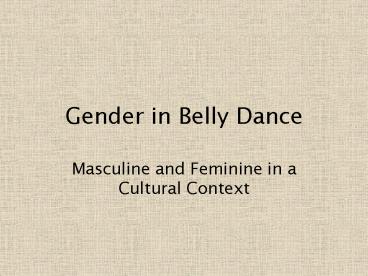Gender in Belly Dance - PowerPoint PPT Presentation
Title:
Gender in Belly Dance
Description:
Gender in Belly Dance Masculine and Feminine in a Cultural Context Gender in Belly Dance Masculine and Feminine in a Cultural Context Primary Sources Primary Source ... – PowerPoint PPT presentation
Number of Views:96
Avg rating:3.0/5.0
Title: Gender in Belly Dance
1
Gender in Belly Dance
- Masculine and Feminine in a Cultural Context
2
Primary Sources
- Primary Source Material from the culture or
material from the historical period under
consideration. Examples - descriptions of dance from the Arab world or from
a historical period - Visual images of dance from the place or period
under discussion - Videos of dance from the place or period
- Primary sources still require interpretation
they can speak directly only of their own time,
place and cultural perspective. - Primary sources can be misleading because
- Their source has misleading information or ideas
- They have other purposes than conveying
information - Even though they may describe another period,
they can speak only about their own.
3
Secondary Sources
- Secondary Sources Sources which speak of or
reconstruct the dance of other times and places
often with an interpretive framework. Examples - Modern descriptions of ancient belly dance
- Western interpretations of Eastern dance
practices - Scholarly interpretations or descriptions of
dance from early sources - Secondary sources can provide valuable
perspective because they can draw on expertise
that goes beyond what a primary source document
shows - They inevitably reproduce modern modes of thought
and analysis (ex. The Goddess, booking agents,
attention to structural categories) - Internet Sources May be primary or secondary
the Internet can convey both types of information.
4
The Gender of Dance
In the modern West, dance is almost always
gendered as feminine.
5
The Gender of Dance
?What are some of the aspects of dance we
classify as feminine? ?What definitions of
femininity and masculinity does our idea of dance
as feminine express? (List some be ready to
discuss them.) ?What are some of the aspects of
belly dance in particular that strike our culture
as feminine?
6
Male dancers
- In traditional cultures, dance often relates to
metaphysics (or religion). Since both male and
female have metaphysical importance, both male
and female dance - Dances tend to be segregated
- Different characteristic movements, or qualities
of movement, express cultural ideas of gender
(but watch for biased descriptions)
Male dancer, Fiji, early 20th century
(non-professional)
7
Male Dancers
Professional folkloric troupes may reflect
politically correct (for their culture)
encodings of gender more than real folkloric
dance (ex. Reda Troupe)
Male dancer from New Guinea (A national folkloric
troupe)
8
Male Dancers
Professional dervish dancer, Egypt
Dancers often reflect ideas of inappropriate
gender behavior (females public life men
undignified behavior or receptive sexuality)
9
Sexuality and Culture
Aint I a woman? That man over there says that
women need to be helped into carriages, and
lifted over ditches, and to have the best place
everywhere. Nobody ever helps me into carriages,
or over mud-puddles, or gives me any best place!
And ain't I a woman? Look at me! Look at my arm!
I have ploughed and planted, and gathered into
barns, and no man could head me! And ain't I a
woman? I could work as much and eat as much as a
man - when I could get it - and bear the lash as
well! And ain't I a woman? I have borne thirteen
children, and seen most all sold off to slavery,
and when I cried out with my mother's grief, none
but Jesus heard me! And ain't I a woman?
Sojourner Truth, 1851
- Sexuality and sexual preference are largely
cultural constructs. Constructs can vary between
cultures and within cultures. - Some central ideas
- Womens sexuality relative to mens
- Homosexual identity vs. homosexual acts
10
Male dancers
Turkish Kocek The kocek danced in troupes and as
soloists They were considered very desirable and
also disruptive to ordinary morality Costumed,
but in a masculine way (what are some
indications?)
11
(No Transcript)
12
Kocek, early 20th century
13
Bert Balladine, 1960s and 70s
14
Ibrahim Farrah, 1970s
15
Amir Thaleb of Argentina
16
Horacio and Beata Cifuentes, Germany
17
Jim Boz, San Diego
18
Female Dancers
Female dancers traditional roles have often been
interpreted in the West as erotic
display. Hawaiian hula, originally a highly
structured court dance, was received this way in
the West the naughty hula. Two hula images
from circa 1910
19
Erotic Display
Dance in the 19th century West was seen as erotic
display as well as art Dancers were described in
sensual terms, and patrons were expected to
appreciate their beauty and their allure. Dance
was seen as the vehicle for this allure, rather
than the statement of an active artist.
Dolores has a plump bosom, rounded arms, slender
legs, and tiny feet, and, in addition to being a
very good dancer, is very pretty. If any woman
is required to be beautiful, it must surely be a
dancer.Dance is a wholly sensual and material
art that appeals neither to the intelligence nor
to the heart, but is directed only to the eyes.
(Theophile Gautier)
20
Erotic Display
?Belly dance has a role as a folk dance performed
by men and women. Yet for many reasons, its
performance seen as erotic display in the West.
What are some elements of this dynamic?
Ozel Turkbas
21
Erotic Display
?Is belly dance (and all dance) inevitably
tainted by patriarchal dynamics?
The reason belly dance is performed mostly by
women is that most of the people in power are
heterosexual men, and they want to watch women
dancing. If women held the power, belly dancing
would be mostly performed by men. (Tarik
Sultan, personal communication, paraphrased.)
Prinses Banu































